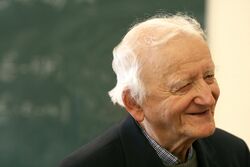Biography:Valentin Franke
Valentin Franke | |
|---|---|
 | |
| Born | 16 February 1926 |
| Nationality | Soviet, Russian |
| Alma mater | Leningrad State University |
| Known for | One of the authors of the FGKLS equation (Lindblad equation) |
| Scientific career | |
| Fields | Theoretical physics |
| Institutions | Saint Petersburg State University |
| Doctoral advisor | Yury Novozhilov |
Valentin Alfredovich Franke (Russian: Валенти́н Альфре́дович Фрáнке) (born 16 February 1926) is a Soviet—Russia theoretical physicist, D. Sc., retired professor of the High Energy & Elementary Particle Physics Department of Saint Petersburg State University.
Biography
V. A. Franke graduated from Kyiv Polytechnic Institute in 1949. After that he was distributed to a power plant in Amur Oblast, Russian Far East. In 1954 he externally graduated from Leningrad State University and then worked in Institute of Labor Protection in Leningrad.[1]
In 1962 V. A. Franke joined the physical faculty of LSU. He obtained his PhD under the supervision of Yury Novozhilov in 1965 and was habilitated in 1984. He was a professor of High Energy & Elementary Particle Physics Department until his retirement in 2020.
Scientific and educational activity
V. A. Franke is working in the fields of elementary particle physics, quantum mechanics and theory of gravitation. He wrote more than 70 papers on these topics.
In 1976 V. A. Franke obtained the general form of the renowned master equation for the evolution of density matrix. This equation was derived independently and simultaneously by V. A. Franke,[2] G. Lindblad[3] and V. Gorini, A. Kossakowski and E. C. G. Sudarshan[4] (see [5][6]). FGKLS (Franke-Gorini-Kossakowski-Lindblad-Sudarshan) equation plays an important role in the description of open quantum systems and the quantum measurement theory. V. A. Franke himself considered this equation as a natural generalisation of standard quantum mechanics, whose validity has to be proven experimentally.[7]
Since 1981 V. A. Franke and his colleagues have been working on the light front quantization of the Yang—Mills theory. This approach proves itself useful in non-perturbative description of quantum chromodynamics.[8]
After the death of his long-time friend and colleague, Yuri Yappa, V. A. Franke had completed and edited his unfinished monograph on the spinor theory.[9]
References
- ↑ "Valentin A. Franke". http://hep.phys.spbu.ru/science/franke_e.htm.
- ↑ Franke, V. A. (1976). "On the general form of the dynamical transformation of density matrices" (in en). Theoretical and Mathematical Physics 27 (2): 406–413. doi:10.1007/BF01051230. ISSN 0040-5779. http://link.springer.com/10.1007/BF01051230.
- ↑ Lindblad, G. (1976). "On the generators of quantum dynamical semigroups" (in en). Communications in Mathematical Physics 48 (2): 119–130. doi:10.1007/BF01608499. ISSN 0010-3616. http://link.springer.com/10.1007/BF01608499.
- ↑ Gorini, V.; Kossakowski, A.; Sudarshan, E. C. G. (1976). "Completely positive dynamical semigroups of N‐level systems". Journal of Mathematical Physics 17 (5): 821. doi:10.1063/1.522979.
- ↑ Chruściński, Dariusz; Pascazio, Saverio (2017). "A Brief History of the GKLS Equation" (in en). Open Systems & Information Dynamics 24 (3): 1740001. doi:10.1142/S1230161217400017. ISSN 1230-1612. https://www.worldscientific.com/doi/abs/10.1142/S1230161217400017.
- ↑ Andrianov, A A; Ioffe, M V; Novikov, O O (2019-10-18). "Supersymmetrization of the Franke–Gorini–Kossakowski–Lindblad–Sudarshan equation". Journal of Physics A: Mathematical and Theoretical 52 (42): 425301. doi:10.1088/1751-8121/ab4338. ISSN 1751-8113. https://iopscience.iop.org/article/10.1088/1751-8121/ab4338.
- ↑ Franke, V. A. (2006). Novozhilov, V.. ed. "The foundations of quantum theory and its possible generalizations". Proceedings of the 15th International V. A. Fock School for Advances of Physics 2005 (SPbU Publ.).
- ↑ Bakker, B.L.G.; Bassetto, A.; Brodsky, S.J. et al. (2014). "Light-front quantum chromodynamics" (in en). Nuclear Physics B - Proceedings Supplements 251-252: 165–174. doi:10.1016/j.nuclphysbps.2014.05.004. Bibcode: 2014NuPhS.251..165B. https://linkinghub.elsevier.com/retrieve/pii/S0920563214000930.
- ↑ Yappa, Yu. A. (2004). Franke, V. A.. ed. An Introduction to Spinor Theory and Its Applications in Physics. Saint Petersburg: SPb State University Publ.. ISBN 5-288-01951-7.
 |

